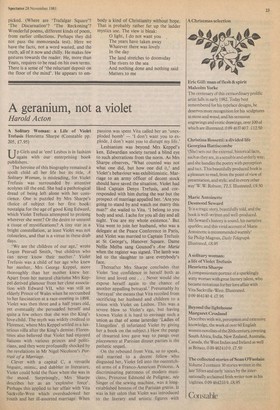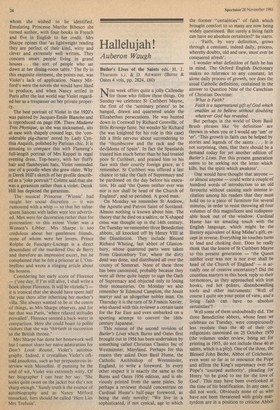A geranium, not a violet
Harold Acton
A Solitary Woman: a Life of Violet Trefusis Henrietta Sharpe (Constable pp. 205, £7.95) Up Girls and at 'em! Lesbos is in fashion again with our enterprising book publishers.
The heroine of this biography remained a spoilt child all her life but its title, A Solitary Woman, is misleading, for Violet Trefusis was surrounded by attentive acolytes till the end. She had a pathological dread of being left alone with her conscience. One is puzzled by Mrs Sharpe's choice of subject for her first book: nostalgia for the age of good King Edward, which Violet Trefusis attempted to prolong wherever she went? Or the desire to unravel a tissue of mystifications? A tiny star in a bright constellation, at least Violet was not colourless, and that is a virtue in these drab days.
'We are the children of our age,' wrote Logan Pearsall Smith, 'but children who can never know their mother.' Violet Trefusis was a child of her age who knew her mother, Mrs George Keppel, more thoroughly than her mother knew her. Apart from her natural charisma Mrs Keppel derived glamour from her close association with Edward VII, who was still an elderly Prince of Wales when he succumbed to her fascination at a race-meeting in 1898. Violet was then three and a half years old, yet eventually she persuaded herself and quite a few others that she was the King's love-child. The myth was widely credited in Florence, where Mrs Keppel settled in a luxurious villa after the King's demise. Florentines also believed that Violet had enjoyed liaisons with various princes and politicians, and they were profoundly shocked by the revelations in Mr Nigel Nicolson's Portrait of a Marriage.
Clever with a capital C, a versatile linguist, mimic, and dabbler in literature, Violet could hold the floor when she was in the mood. Surprisingly, Mrs Sharpe describes her as an 'explosive force'. Perhaps this applied to her affair with Vita Sackville-West which overshadowed her Youth and her ill-assorted marriage. When passion was spent Vita called her an 'unexploded bomb' — 'I don't want you to explode. I don't want you to disrupt my life.'
Lesbianism was beyond Mrs Keppel's ken. Edwardian society turned a blind eye to such aberrations from the norm. As Mrs Sharpe observes, 'What counted was not what one did, but how one did it,' and Violet's behaviour was exhibitionistic. Marriage to an army officer of decent stock should have saved the situation. Violet had liked Captain Denys Trefusis, and corresponded with him during the war but the prospect of marriage appalled her. 'Are you going to stand by and watch me marry this man?' she wailed to Vita. 'I belong to you body and soul. I ache for you all day and all night. You are my whole existence.' But Vita went to join her husband, who was a delegate at the Peace Conference in Paris, and Violet was married to Captain Trefusis at St George's, Hanover Square. Dame Nellie Melba sang Gounod's Ave Maria when the register was signed. The lamb was led to the slaughter to save everybody's face.
Thereafter Mrs Sharpe concludes that Violet 'lost confidence in herself both as lover and loved one . . . Never would she expose herself again to the chance of another appalling betrayal.' Presumably by 'betrayal' she means that Vita recoiled from sacrificing her husband and children to a union with Violet on Lesbos. This was a severe blow to Violet's ego, but having known Violet it is hard to envisage such a union as that of some latterday 'Ladies of Llangollen'. (I infuriated Violet by giving her a book on the subject.) How the pangs of thwarted love gave way to pangs over placements at Parisian dinner parties is the pathetic sequel.
On the rebound from Vita, so to speak, and married to a decent fellow who disgusted her, Violet fell into the oustretched arms of a Franco-American Princess. A discriminating patroness of modern musicians, Princesse Edmond de Polignac, nee Singer of the sewing machine, was a longestablished hostess of the Parisian gratin. It was in her salon that Violet was introduced to the literary and artistic figures with whom she wished to be identified. Emulating Princesse Marthe Bibesco she turned author, with four books in French and five in English to her credit. Mrs Sharpe opines that 'as lightweight reading they are perfect of their kind, witty and clever and extremely well written. They concern smart people living in grand houses . . . the sort of people who sat down at her dining-room table.' The fly in this exquisite ointment, she points out, was Violet's lack of application. Nancy Mitford's were the novels she would have liked to produce, and when Nancy settled in Paris after the last world war Violet regarded her as a trespasser on her private property.
The best portrait of Violet in the 1920's was painted by Jacques-Emile Blanche and is reproduced on page 106. There Madame Tres Physique, as she was nicknamed, sits at ease with shapely crossed legs, the 'considerable pig-charm' noted by Lady Cynthia Asquith, polished by Parisian chic. It is amusing to compare this with Flameng's full-length portrait of Mrs Keppel in regal evening dress. Top-heavy, with her fluffy hair and flamboyant hats, Violet reminded one of a poodle when she grew older. Why is Derek Hill's sketch of her profile described as a 'joke portrait'? Colette said that she was a geranium rather than a violet: Derek Hill has depicted the geranium.
The musical Princesse Winnie' had taught her social discretion — it was rumoured with a whip — so that her subsequent liaisons with ladies were less advertised. Men were for decoration rather than for procreation: to this extent Violet was a Women's Libber. Mrs Sharpe is too credulous about her gentlemen friends, none of whom were her lovers. Prince Rolphe de Faucigny-Lucinge is a direct descendant of the murdered Duc de Berry and therefore an impressive escort, but he complained that he felt a prisoner at L'Ombrellino and wrote a stinging article about his hostess.
Considering her early scorn of Florence — 'one day, if I'm still alive, I shall write a book about Florence. It will be vitriolic') — it is ironical that she should have spent half the year there after inheriting her mother's villa. She always wanted to be at the centre of things, as Mrs Sharpe observes, and for her that was Paris, 'where relaxed attitudes prevailed'. Florence seemed a back-water in comparison. Here she could boast to polite visitors that she was 'thirtieth in succession to the British throne.'
Mrs Sharpe has done her homework well but I cannot share her naive admiration for Don't Look Round, Violet's autobiography. Indeed, it crystallises Violet's ofttold anecdotes, such as her preposterous interview with Mussolini. If punning be the soul of wit, Violet was extremely witty. Of her biographer I can hear her say: 'She looks quite sweet on the jacket but she's not sharp enough.' Surely truth is the essence of autobiography and as Nancy Mit ford remarked, hers should be called 'Here Lies Mrs Trefusis'.















































 Previous page
Previous page